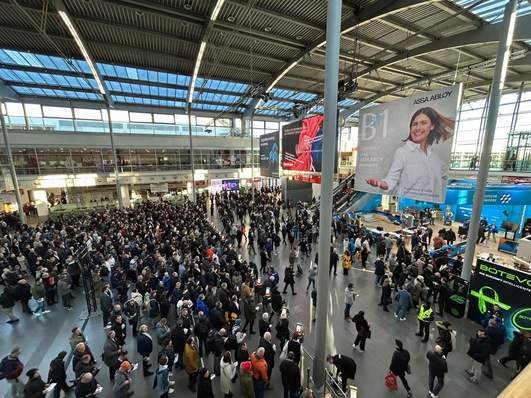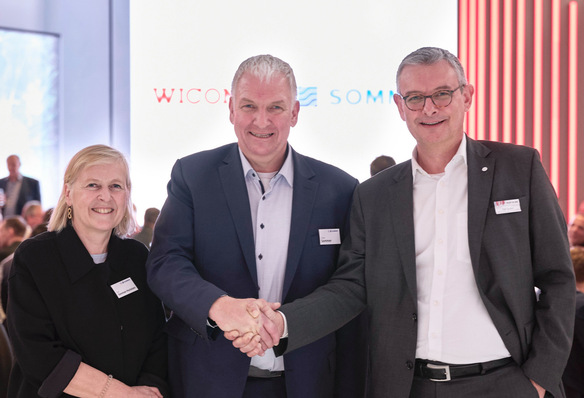The house which was designed by Freiburg-based architectural practice Harter + Kanzler & Partner is located in a building development area with some historical buildings on its doorstep. The client wanted a barrier-free family home which fitted in with the hillside topography and ensemble of existing buildings on the plot and was oriented towards the large garden leading down the valley.
Slotted into the hillside, the reinforced concrete building structure with forward-mounted clinker brick façade was positioned on the plot of land so as to save space and build over as little garden as possible. While from the street the building appears to be one storey high and largely closed off, the extended two-storey structure opens up towards the garden with large room-height glazing, creating a smooth transition between inside and outside. The roof, with some cantilevered sections, and the balcony on the upper floor connect the house and garage to form one unit. The roof and balcony lines highlight the elongated character of the building, which is heightened by the use of horizontally stacked clinker bricks.
Discreet, open usage zones
The building is accessed from the hillside on the upper floor by means of a covered area between the house and garage. The view is immediately directed towards the large garden, both in the outside entrance area and in the porch. The upper floor, which leads out to the street, is a private place to retreat. Bedrooms, dressing rooms and bathrooms are arranged in a functional way and all face the garden with floor-to-ceiling glazing. Each room has direct access outside via the adjoining balcony which spans almost the full width of the house. Room-height, glazed sliding door systems create a lengthwise visual axis through the entire sequence of rooms. At the centre, a single-flight, freestanding staircase leads down to the living space below with its large lounge and dining area, open kitchen, fireplace and library.

Schüco International KG / Olaf Herzog
The building's external wall on the street side appears on the lower floor as the white plastered rear wall of the living area. It is adorned with artwork and provides the backdrop for the cantilevered staircase, while the area of the building behind this wall is completely buried in the ground. A second more private space which is used as a library, TV room and office is directly connected to the open living area here. A fireplace in the wall can be used in both rooms. Directly connected to the kitchen are the more private rooms including the utility area and guest and children's bedrooms, which all face the garden through room-height glazing too.
Maximum transparency and natural light
Transparency is created by floor-to-ceiling glazing, the profiles of which are concealed so that wall, floor and ceiling can run from inside to outside in a continuous, easy-access design – the barriers between indoors and outdoors are thereby visually and spatially removed. Light can flood into the rooms, while roof overhangs and cantilevered balconies provide structural sun shading and change the light levels. A toplight in the roof area directs light to the staircase and rear wall, right down to the living space below.
Variable light openings
See also this article:
Balancing daylight access with solar shading
The level and intensity of transparency can be adjusted according to requirements. In addition to the external sun shading, lightweight, white curtains in front of the glass on the inside provide a diffuse filter. The feeling of natural light can be recreated at night using artificial light in conjunction with the glass fronts and the lights embedded in the floor, illuminating the building outside.

Schüco International KG / Olaf Herzog
All of the light openings were designed with large Schüco system units with flexible opening options. The Schüco ASS 77 PD.SI sliding system was used as a highly insulated option with triple glazing. The ceiling and floor profiles of the 2.95 metre-high units were installed in such a way that they are concealed, so that only the slimline centre mullions and vertical profiles of the sliding units are visible. This created large, transparent façade areas without visible horizontal frames and with just a few very narrow vertical structures. Unit lengths of 7.98 m, 2.70 m and 5.35 m run along the ground floor to the balcony. On the lower floor, which has access to the garden and to the patio at the side, the total length of all the units is 32.50 m, distributed across five system units of differing widths. In order to create optimum ease of use, the sliding systems were fitted with motorised drives for contactless opening and closing.
Sustainable energy concept
The sustainable energy concept was based on a well-insulated building envelope consisting of load-bearing masonry, mineral wool insulation, an air layer and clinker facing. Solar heat gain during the colder months, which is achieved through the floor-to-ceiling glazing, was specifically included in the calculation. Sun shading for the warmer months is ensured through structural features such as the balcony and projections as well as internal and external sun shading. Fresh air is fed in to the living spaces by means of displacement ventilation, while outgoing air is automatically extracted from the adjacent rooms such as the bathroom.

Schüco International KG / Olaf Herzog
At the centre of the energy-efficient building technology is underfloor heating with a summer cooling function operated by means of ground-source heat/heat pump. The heating system receives "natural" support by means of solar heating as well as roof photovoltaics with solar energy storage panels.













